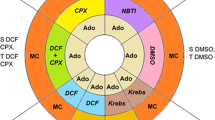Summary
Myocardial mechanics and oxygen consumption were studied in right ventricular papillary muscles taken from cats pretreated with cristalline L-thyroxine (1 mg/kg/day, i.p.) 8–18 days prior to the examination. Isotonic afterloaded and isometric contractions were employed. Oxygen consumption was determined polarographically. Data obtained were compared with control studies on papillary muscles taken from euthyroid cats.
In isotonic afterloaded contractions the extent of shortening was nearly identical in bot groups. However, maximum rate of isometric tension development and velocity of isotonic shortening were considerably increased in hyperthyroid myocardium. Myocardial oxygen consumption was significantly increased in hyperthyroidism, primarily due to an increased maximum rate of isometric tension development and — to a lesser extent — to increased isotonic contraction velocity.
In isometric contractions maximum tension development (preload near Lmax) was similar in both groups. However, maximum rate of isometric tension development was markedly increased in hyperthyroidism. A close and linear relationship was found between maximum rate of isometric tension development (isometric contraction) and myocardial oxygen consumption.
The results demonstrate increases of velocity factors of myocardial performance in experimental hyperthyroidism. Myocardial oxygen consumption is significantly increased. This increase in oxygen consumption quantitatively has its mechanical equivalent in increased isometric contraction velocity and, to a small amount, in increased isotonic contraction velocity.
Zusammenfassung
Herzmechanik und myokardialer Sauerstoffverbrauch wurden an rechtsventrikulären Papillarmuskeln von euthyreoten und hyperthyreoten Katzen untersucht. Die experimentelle Hyperthyreose wurde durch intraperitoneale Injektion von L-Thyroxin (1 mg/kg/Tag 8–18 Tage) erzeugt. Der Sauerrstoffverbrauch wurde polarographisch bestimmt.
In isotonischen, isometrischen und Unterstützungskontraktionen waren die Gesch windigkeitsgrößen der Kontraktionsphase bei der Hyperthyreose erheblic gesteigert. Parallel dazu war eine quantitativ vergleichbare Zunahme des myokardialen Sauerstoffverbrauches nachweisbar. Es bestand eine enge Beziehung zwischen der maximalen isometrischen Spannungsanstiegsgeschwindigkeit und dem myokardialen Sauerstoffverbrauch. Die Befunde lassen den Schluß zu, daß der gesteigerte myokardiale Energiebedarf bei der Hyperthyreose durch eine Veränderung herzmechanischer Größen entsprechend einer Kontraktilitätssteigerung erklärbar ist.
Similar content being viewed by others
References
Braunwald, E., Control of myocardial oxygen consumption. Physiological and clinical considerations. Amer. J. Cardiol.27, 416 (1971).
Buccino, R. A., J. F. Spann, P. E. Pool, E. H. Sonnenblick, E. Braunwald, Influence of the thyroid state on the intrinsic contractile properties and energy stores of the myocardium. J. Clin. Invest.46, 1669 (1967).
Graham, T. P., J. P. Covell, E. H. Sonnenblick, J. Ross, Jr., E. Braunwald, Control of myocardial oxygen consumption. Relative influence of contractile state and tension development. J. Clin. Invest.47, 375 (1968).
Grote, J., G. Thewes, Die Bedingungen für die Sauerstoffversorgung des Herzmuskelgewebes. Pflügers Arch. Ges. Physiol.276, 142 (1962).
Gunning, J. F., C. E. Harrison, H. N. Coleman, The effect of chronic potassium deficiency on myocardial contractility and oxygen consumption. J. Mol. Cell. Cardiol.4, 139 (1972).
Hoch, F. L., Thyreotoxicosis as a disease of mitochondria. New Engl. J. med.266, 446 (1962).
Hoch, F. L., Biochemical actions of thyroid hormones. Physiol. Rev.42, 605 (1962).
Kjekhus, J., H. Frey, Effect of thyroxine on myocardial function and oxygen consumption. Acta Physiol. Scand.73, 44 (1968).
Skelton, L., P. E. Pool, Sh. Seagren, E. Braunwald, Mechanochemistry of cardiac muscle V. Influence of thyroid state on energy utilization. J. clin. Invest.50, 463 (1971).
Skelton, L. C., H. M. Coleman, K. Wildenthal, E. Braunwald, Augmentation of myocardial oxygen consumption in hyperthyroid cats. Circulat. Res.27, 301 (1970).
Sonenblick, E. H., The determinants of oxygen consumption of the heart. In: Heart failure (Stuttgart 1968), p. 271.
Strauer, B. E., M. Tauchert, H. W. Heiss, K. Kochsiek, H. J. Bretschneider, on the relations between coronary blood flow, oxygen consumption and cardiac work in patients with and without angina pectoris. In:A. Maseri (Ed.). Myocardial blood flow in man, methods and significance in coronary disease. P. 465 (Torino 1972).
Strauer, B. E., Forcevelocity relations of isotonic relaxation in mammalian heart muscle. Amer. J. Physiol.224, 431 (1973).
Strauer, B. E., Der Mechanismus der Nitroglycerinwirkung vom Aspekt der Myokardkontraktilität: Tierexperimentelle Studien sowien Untersuchungen am isolierten menschlichen Ventrikelmyokard. Z. Cardiol.62, 97 (1973).
Strauer, B. E., Contractile responses to morphine, piritramide, pethidin and fentanyl. A comparative study on the isolated ventricular myocardium. Anaesthesisology37, 304 (1972).
Strauer, B. E., A. Scherpe, Experimental hyperthyroidism. I.: Hemodynamics and contractility in situ. Basic Res. Cardiol.70, 115–129 (1975).
Strauer, B. E., A. Scherpe, Experimental hyperthyroidism. II. Myocardial mechanics and contractility of isolated ventricular myocardium. Basic Res. Cardiol.70, 130–141 (1975).
Strauer, B. E., A. Scherpe, Experimental hyperthyroidism. III. Contractile responses to propranolol of the intact heart and of the isolated ventricular myocardium. Basic Res. Cardiol.70, 237–245 (1975).
Strauer, B. E., M. Tauchert, Evidence for an inefficient energy utilization in cardiac hypertrophy. Studies on the isolated human ventricular myocardium. Klin. Wschr.51, 322 (1973).
Tata, J. R., Basal metabolic rate and thyroid hormones. In:R. Levine andR. Luft (Edd.), Advances in metabolic disorders, Vol. 1, p. 153 (New York 1964).
Author information
Authors and Affiliations
Additional information
With 6 figures
Supported by Deutsche Forschungsgemeinschaft, SFB 89 — Kardiologie, Göttingen.
Rights and permissions
About this article
Cite this article
Strauer, B.E., Scherpe, A. Experimental hyperthyroidism IV Myocardial muscle mechanics and oxygen consumption in eu-and hyperthyroidism. Basic Res Cardiol 70, 246–255 (1975). https://doi.org/10.1007/BF01905508
Received:
Issue Date:
DOI: https://doi.org/10.1007/BF01905508




